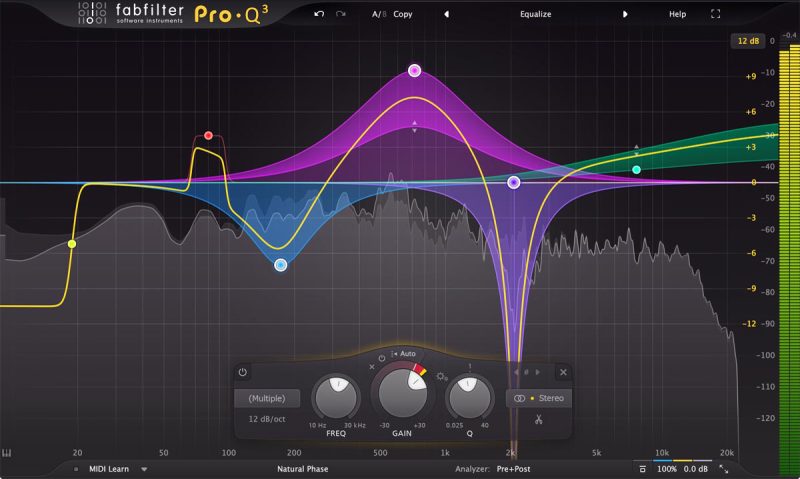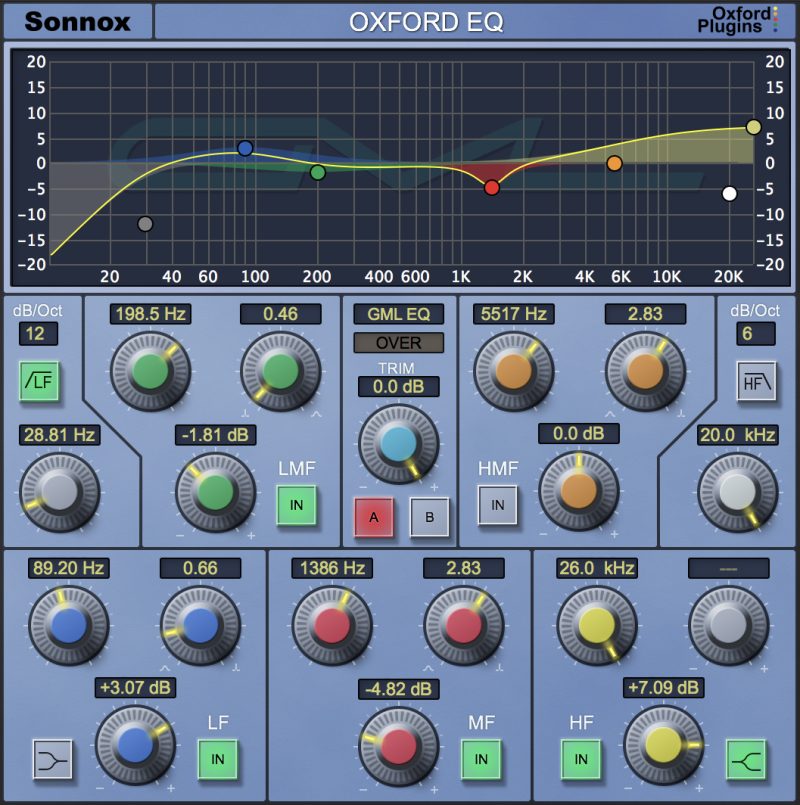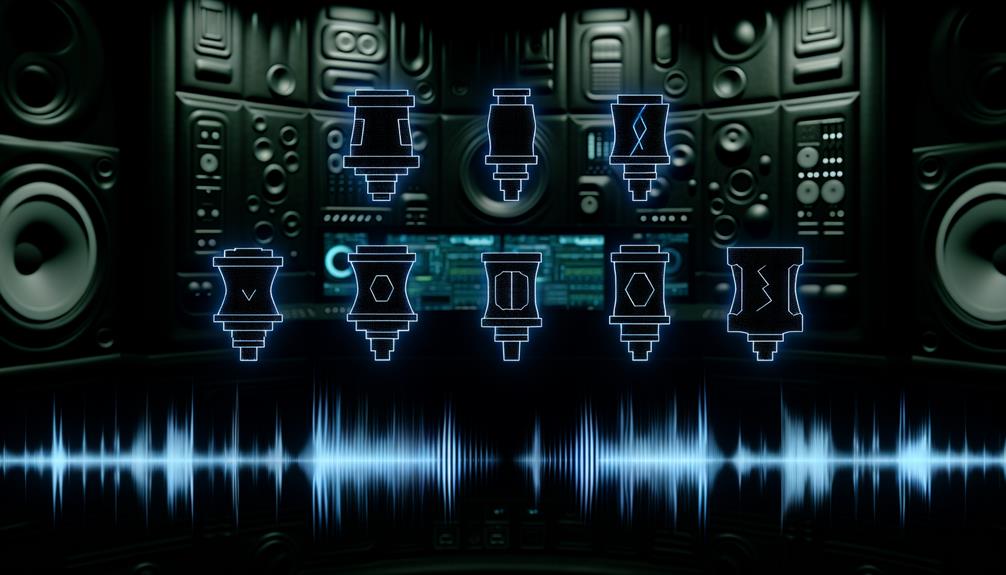No products in the cart.
In the world of music production, achieving the perfect sound is a constant pursuit for producers and engineers. One essential tool in this quest is the EQ plugin. But what exactly is an EQ plugin and why is it crucial for music production? In this article, we will delve into the world of EQ plugins, exploring their significance in shaping and enhancing audio, and uncovering the key factors to consider when choosing the right EQ plugin for your projects. We will showcase the top 5 EQ plugins that have earned acclaim in the music production community, and provide insights on how to effectively utilise these tools to elevate your sound. Whether you’re a seasoned professional or a budding music creator, understanding the role of EQ plugins and harnessing their potential can truly revolutionize your music production journey. So, without further ado, let’s dive into the world of EQ plugins and discover the transformative impact they can have on your music.
Key Points:
An EQ plugin is a software tool used in music production to adjust the frequency balance of a track. EQ plugins are essential for creating a balanced and polished sound in your music production. When choosing an EQ plugin, consider factors such as compatibility, user interface, sound quality, and additional features.
What is an EQ Plugin?
An EQ plugin, also known as an equaliser plugin, is a fundamental tool used in music production to modify the frequency response of audio signals.
These plugins allow music producers to shape the tonal balance of individual tracks or entire mixes by adjusting specific frequency bands. By precisely boosting or cutting frequencies, EQ plugins enable the enhancement of certain aspects of the audio, such as the clarity of vocals, the warmth of the bass, or the brilliance of the high-end frequencies.
Along with corrective functions, EQ plugins can also be used creatively to add character and colour to the sound, making them essential for achieving the desired sonic texture in a musical composition. They play a crucial role in carving out space for different instruments within the mix, contributing to a more balanced and cohesive overall sound.
Why Do You Need an EQ Plugin for Music Production?
In music production, an EQ plugin is essential for shaping and sculpting the tonal characteristics of audio tracks, allowing for precise control over the frequency content and overall sonic balance.
EQ plugins play a crucial role in the signal processing chain, enabling music producers to enhance and modify the sound of individual instruments or vocals. Whether it’s removing unwanted frequencies, boosting specific bands to add warmth, or creating dramatic tonal adjustments, EQ plugins give professionals the tools to refine audio elements with precision and finesse.
EQ plugins enable dynamic shaping, enableing producers to tailor the expressive qualities of sound. By adjusting the dynamic range, they can achieve a more balanced and controlled audio mix, enhancing the overall clarity and impact of the music.
What to Look for in an EQ Plugin?
When selecting an EQ plugin for music production, it’s crucial to consider the available options, such as dynamic and parametric EQ features, to meet the specific requirements of your workflow.
Dynamic capabilities play a significant role in shaping the tonal balance of audio tracks, allowing for precise control over frequency bands. Look for plugins that offer flexible dynamic EQ functionality, enabling you to smoothly adjust the intensity of equalisation based on the input signal’s dynamics. Parametric controls are essential for fine-tuning specific frequency ranges, which is particularly useful for eliminating resonances or enhancing desired sonic characteristics. Consider the range of available options, including graphic, linear phase, and vintage EQ models, to ensure compatibility with diverse music genres and mixing scenarios.
Compatibility with Your DAW
Compatibility with your Digital Audio Workstation (DAW) is paramount when selecting an EQ plugin, ensuring seamless integration and optimal performance within your production environment.
When your EQ plugin is compatible with your DAW, it allows for a smooth and efficient workflow by seamlessly integrating with your existing setup. This compatibility ensures that you can focus on creating and mixing your audio without any technical hiccups, resulting in a more productive and creative environment.
Having EQ plugins that are compatible with your DAW enables you to utilise the full potential of your production setup, leveraging the native features and functionalities of your software. This level of integration not only enhances the user experience but also maximises the effectiveness of your tools, ultimately impacting the quality of your audio productions.
User Interface and Ease of Use
An intuitive user interface and ease of use are vital considerations when evaluating EQ plugins, as they directly impact the workflow efficiency and accessibility of essential controls.
When a user interface is well-designed, it helps streamline the navigation, making it easier for audio engineers to access critical features swiftly. This leads to improved productivity and allows for seamless adjustments to EQ parameters, resulting in a more efficient workflow.
The ease of use of EQ plugins significantly influences their overall practicality. User-friendly interfaces contribute to a smoother operation, enabling users to focus on the creative aspect of their work rather than struggling with complex controls. This, in turn, allows for a more natural and intuitive operation, ultimately leading to enhanced productivity and better quality of music production overall.
Sound Quality
The sound quality delivered by an EQ plugin is a critical factor, influencing the tonal precision, transparency, and overall sonic enhancement capabilities within a music production context.
Regarding tonal precision, EQ plugins play a pivotal role in sculpting the frequency response of audio signals, allowing for fine adjustments across the entire spectrum. A high-quality EQ plugin can ensure that each frequency is accurately represented, maintaining the intended tonal balance and harmonic richness.
In terms of transparency, a top-notch EQ plugin minimizes phase shifts and artifacts, preserving the original character of the audio. This sonic transparency is essential for maintaining the natural timbre and spatial detail, contributing to a more authentic and immersive listening experience.
The sonic enhancement capabilities of an EQ plugin are amplified by superior sound quality. A well-designed EQ plugin can effectively shape the audio, adding depth, dimension, and clarity without introducing unwanted colouration or distortions.
Additional Features
When evaluating EQ plugins, assessing the availability of additional features such as dynamic processing, mid-side EQ, and harmonic enhancement can significantly expand the creative and corrective capabilities within music production.
Dynamic processing in EQ plugins allows for dynamic adjustments to the frequency content, enabling the shaping of audio signals with greater precision. This feature opens up a realm of possibilities for emphasising or attenuating specific elements in a mix, contributing to a more nuanced and polished sound.
Mid-side EQ offers a unique approach to EQ processing by separately adjusting the centre (mono) and side (stereo) information in an audio signal. This capability greatly enhances spatial control and allows for fine-tuning the stereo image, adding depth and clarity to the mix.
Harmonic enhancement, another valuable feature, introduces colour and character to the audio. It enriches the sonics by adding harmonics and saturation, resulting in a warmer, more vibrant sound that can elevate the overall production quality.
The Top 5 EQ Plugins for Music Production
Several exceptional EQ plugins have gained prominence in the realm of music production, including:
- FabFilter Pro-Q 3, known for its intuitive interface and transparent sound, allows for precise frequency adjustments with its dynamic EQ mode and mid/side processing capabilities.
- Oeksound Soothe2, on the other hand, specialises in dynamic resonance suppression, making it an essential tool for managing harsh frequencies and controlling sibilance in vocals and instruments.
- Kush Audio Clariphonic DSP MkII is revered for its parallel high-frequency EQ, accentuating the air and brilliance in audio without harshness, creating a smooth and natural top-end enhancement.
- SoundRadix SurferEQ 2 implements pitch-tracking EQ, which dynamically adjusts the frequency emphasis based on the note played, offering a novel approach to tonal shaping, especially for melodic instruments.
- Meanwhile, Eiosis AirEQ stands out with its unique curves and characterful sound, enabling musical tonal shaping and broad sound sculpting. Its emulation of analogue EQ behaviour offers warmth and musicality to audio tracks.
These EQ plugins offer unique features that cater to different aspects of audio processing.
FabFilter Pro-Q 3

FabFilter Pro-Q 3 stands as a flagship EQ plugin renowned for its unrivalled precision, intuitive interface, dynamic EQ capabilities, and exceptional sound quality, making it a top choice for music producers and engineers.
With its unparalleled precision, Pro-Q 3 offers an extensive range of features that enable users to sculpt and shape their audio with meticulous detail. The user-friendly interface allows for effortless navigation and quick access to all essential functions, enhancing workflow efficiency.
One of its standout capabilities is the dynamic EQ functionality, which enables users to target problematic frequencies in real-time, providing greater control and flexibility during the mixing and mastering process.
Waves SSL E-Channel
The Waves SSL E-Channel EQ plugin is revered for its emulated analogue sound characteristics, classic SSL console heritage, and versatile parametric EQ options, catering to the sonic preferences of discerning music producers.
One of the most notable features of the SSL E-Channel EQ plugin is its ability to replicate the distinct warmth and colouration of analogue hardware, bringing the coveted sonic characteristics of SSL’s legendary consoles into the digital realm. This meticulous emulation captures the essence of the original hardware, ensuring that users can access the same rich, musical sound that has adorned countless hit records.
The plugin’s lineage to SSL’s heritage ensures that it carries forward the legacy of the renowned console manufacturer, delivering the same high-quality audio processing that has been trusted by top engineers for decades. This pedigree not only instils confidence in its sonic performance but also gives producers access to a piece of audio engineering history.
The parametric EQ controls on the Waves SSL E-Channel EQ plugin offer exceptional precision and flexibility in shaping the sound. With its adjustable frequency, bandwidth, and gain parameters, users can precisely tailor the tonal balance of their audio material, whether it’s for subtle enhancements or surgical corrections. This level of control enables music producers to sculpt their tracks with the utmost precision, making it a go-to choice for demanding mixing and mastering tasks.
iZotope Ozone 11 Equalizer
iZotope Ozone 11 Equalizer offers a comprehensive suite of EQ modules, dynamic processing tools, vintage emulations, and modern digital enhancements, providing a versatile and all-encompassing EQ solution for diverse music production needs.
The EQ modules within iZotope Ozone 11 Equalizer are intelligently designed to handle various aspects of frequency shaping with precision and flexibility. They allow for surgical adjustments in the mid-range, broad strokes in the low-end, and delicate fine-tuning in the high frequencies. The dynamic processing tools integrated into the Equalizer leverage advanced algorithms to dynamically adjust the EQ settings in response to the audio signal, ensuring a balanced and consistent output.
iZotope Ozone 11 Equalizer features vintage emulations that pay homage to the classic hardware EQ units, enabling music producers to infuse their tracks with the warmth and character reminiscent of analogue recordings. The modern digital enhancements, on the other hand, incorporate cutting-edge technology to deliver transparent and artifact-free processing, offering pristine clarity and precision in audio equalisation.
Universal Audio API 560 EQ
The Universal Audio API 560 EQ plugin embodies the classic API console EQ sound, delivering an authentic analogue experience with 10 distinct frequency bands, high-quality filtering, and a renowned musical character that resonates with professional music creators.
Renowned for its vintage appeal, the Universal Audio API 560 EQ plugin captures the essence of the iconic API console EQ, known for its ability to impart warmth, punch, and clarity to audio signals. With its 10 frequency bands, including five overlapping mid bands, this plugin provides unparalleled control over shaping the tonal characteristics of individual tracks or entire mixes. The high-quality filtering ensures precise adjustments, allowing users to sculpt their sound with surgical precision.
The renowned musical character of the API 560 EQ plugin is rooted in its rich history and legacy of shaping countless hit records. Its distinctive sonic prowess has made it a coveted tool in professional studios, offering unparalleled tonal shaping capabilities that elevate the overall mix. Whether adding presence to vocals, punch to drums, or shimmer to guitars, this plugin remains an essential component for achieving a signature vintage sound with modern convenience.
Sonnox Oxford EQ


The Sonnox Oxford EQ plugin stands as a pinnacle of precision and musicality, featuring flexible parametric controls, diverse filter options, and a legacy of acclaimed audio processing tools, catering to the discerning demands of modern music production.
With its highly refined parametric controls, Sonnox Oxford EQ lets users fine-tune specific frequencies with exceptional accuracy, providing the ability to sculpt sound with unparalleled precision. The plugin’s diverse filter options, including high-pass, low-pass, and shelving filters, offer remarkable versatility for shaping the tonal characteristics of audio tracks.
The integration of the legacy of acclaimed audio processing tools in the Sonnox Oxford EQ plugin ensures a rich history of expertise and innovation backing its capabilities, making it a go-to solution for professional audio engineers and music producers alike.
How to Use an EQ Plugin in Music Production?
Utilising an EQ plugin effectively in music production entails understanding frequency bands, employing precise mixing techniques, and sculpting the sonic landscape to achieve the desired tonal balance and clarity.
Understanding frequency bands involves grasping the concept that different sections of the audible frequency spectrum can significantly impact the overall sound of the mix. By manipulating these frequency bands using EQ plugins, producers can precisely adjust the level of frequencies to enhance the clarity and balance of the audio.
EQ plugins are essential in mixing applications, allowing for surgical adjustments in the frequency domain. Whether it’s cutting problematic frequencies, boosting specific tonal characteristics, or creating space for different instruments, EQ plugins play a vital role in shaping the final mix.
Sculpting the sonic landscape with EQ plugins is essential for achieving tonal balance and clarity. By attenuating or boosting specific frequencies, musicians can fine-tune the overall sound of individual tracks or the entire mix, resulting in a more polished and professional-sounding production.
Understanding Frequency Bands
Understanding the characteristics and applications of frequency bands is crucial when using EQ plugins in music production, as it enables targeted tonal adjustments and sonic enhancements across the audio spectrum.
EQ plugins depend on dividing the audio spectrum into distinct frequency bands, typically categorized as low, mid, and high frequencies. Each band allows for precise control over the corresponding range of frequencies, enabling musicians and audio engineers to sculpt the tonal balance of a mix with precision. By understanding the unique effect each frequency band has on the overall sound, users can strategically manipulate the EQ parameters to address specific sonic characteristics and achieve a harmonious blend of frequencies.
Using EQ to Correct and Enhance Sounds
Mastering the art of using EQ plug-ins to correct imperfections and enhance the sonic qualities of audio signals is a foundational skill for music producers seeking to achieve professional-grade sound outcomes.
EQ plug-ins play a crucial role in taming frequencies, addressing tonal imbalances, and sculpting the overall audio spectrum. They allow users to pinpoint problematic frequencies and adjust them with precision, ensuring a more balanced and harmonious sound. EQ plug-ins offer the flexibility to shape the sound character, whether it’s adding warmth to vocals, creating a punchier low-end in a mix, or achieving a pristine, transparent high-frequency presence.
Using EQ for Creative Effects
Harnessing the creative potential of EQ plug-ins introduces a realm of sonic experimentation, tonal shaping, and inventive sound manipulation, enabling artists to sculpt unique and captivating auditory experiences within their music productions.
With EQ plug-ins, artists can delve into a plethora of imaginative sonic possibilities, from sculpting the tonal character of instruments and vocals to creating otherworldly soundscapes. Adjustable frequency bands, precise parametric controls, and dynamic EQ features enable artists to push the boundaries of conventional sound and transform ordinary audio sources into extraordinary sonic expressions. By harnessing the power of EQ plug-ins, musicians can take their listeners on an immersive sonic journey, evoking emotions and translating their artistic vision into a profound auditory experience.
Tips for Using EQ Plugins in Music Production


Incorporating EQ plugins effectively into music production requires understanding the nuances of frequency manipulation, employing subtle adjustments, and judiciously selecting the appropriate EQ options to complement the sonic vision of a production.
When manipulating frequencies, it’s crucial to have a clear vision of how the various elements in a mix should interact. Using a parametric EQ allows for precise control over specific frequency bands, enableing producers to sculpt the tonal balance with finesse. Subtle adjustments, such as gentle boosts or cuts in specific frequency ranges, can significantly enhance the clarity and impact of individual tracks, contributing to a more cohesive and polished mix.




